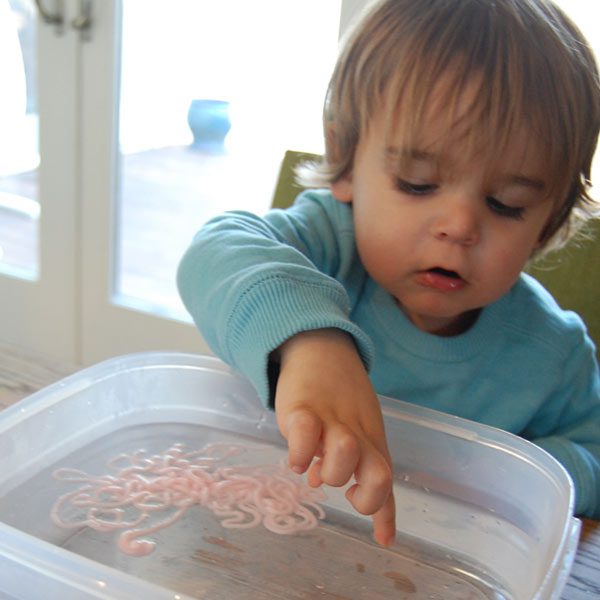
Materials Required
- Clear plastic tub
- Water
- Dish soap
- Shaving cream
- Oil
- Shampoo
- Conditioner
- Measuring cups
- Glitter (optional)
- Liquid watercolor or food coloring (optional)
- Additional kitchen materials/liquids for investigation (optional)
- Paper and pencil (optional)
Instructions
- To begin the activity, fill the clear plastic tub with warm water. Set up dish soap, shaving cream, oil, shampoo, conditioner, and any other materials being used.
- Provide children with the opportunity to play with the materials so they can become familiar with their properties.
- Invite children to make predictions about whether each liquid/material will sink or float, then try it out and see what happens. Encourage children to record their observations.
- Using the measuring cups, children can try different amounts of the materials. Draw their attention to differences and similarities between the way materials respond to each other and the water.
- To begin the activity, fill the clear plastic tub with warm water. Set up shaving cream, oil, glitter, dish soap and any other materials.
- Provide children with the opportunity to play with the materials so they can become familiar with their properties.
- Invite children to make predictions about whether each liquid/material will sink or float, then try it out and see what happens. Encourage children to record their observations.
- Using the measuring cups, children can try different amounts of the materials. Draw their attention to differences and similarities between the way materials respond to each other and the water.
Additional Tips
Try these add-on activities:
- Use a chart for recording observations. Notice what floats, what sinks, and what dissolves in the water. Based on prior experience with the liquids, make a hypothesis about what will happen to each material, then observe whether or not your hypothesis was correct.
- Invite children to collect additional materials to test.
- Try using food coloring or liquid watercolor to change the color of a liquid. Make observations about how that affects the properties of the liquid.
Links to Research
Frequently, creativity occurs in response to a problem that needs solving. Creativity researchers have highlighted how our own experiences and expectations favor established functions, and can get in the way of novel solutions (Duncker, 1945; German & DeFeyter, 2000). Understandably, this happens less often for young children. As children play and become more familiar with the different materials, they are likely to discover different variables and test how they affect floatation. To control for such variables and their effects is an important aspect in creating and testing hypotheses (Chen & Klahr, 1999). By focusing on traits of the materials, children are more likely to think outside of the box and generate different uses for an object (McCaffrey, 2012).
Supporting research includes:
Chen, Z., & Klahr, D. (1999). All other things being equal: Acquisition and transfer of the control of variables strategy. Child Development, 70(5), 1098-1120.
Duncker, K. (1945). On problem-solving (L. S. Lees, Trans.). Psychological Monographs, 58(5, Whole No. 270).
German, T. P., & Defeyter, M. A. (2000). Immunity to functional fixedness in young children. Psychonomic Bulletin & Review, 7(4), 707-712.
McCaffrey, T. (2012). Innovation relies on the obscure: A key to overcoming the classic problem of functional fixedness. Psychological Science, 23(3), 215-218.






